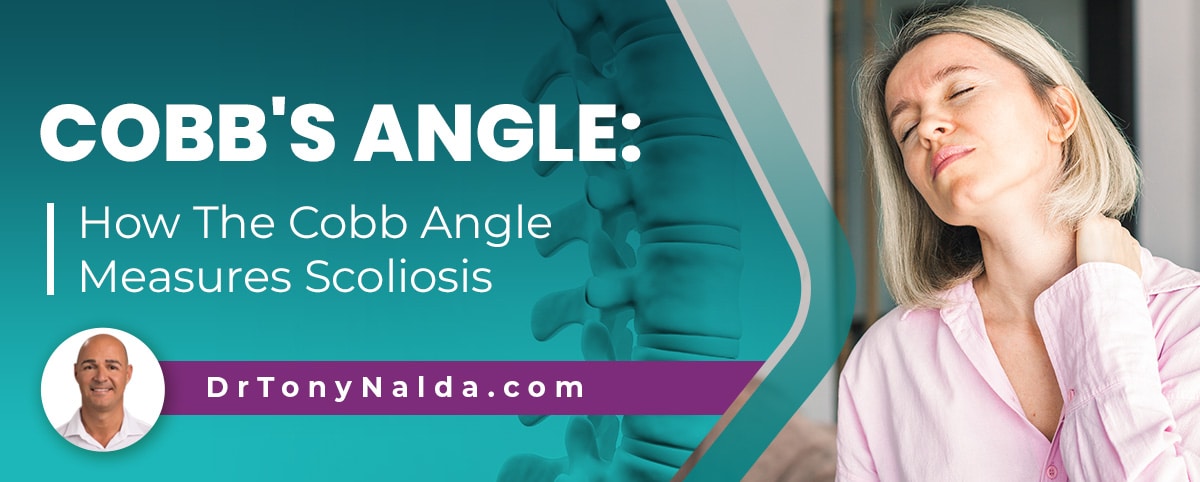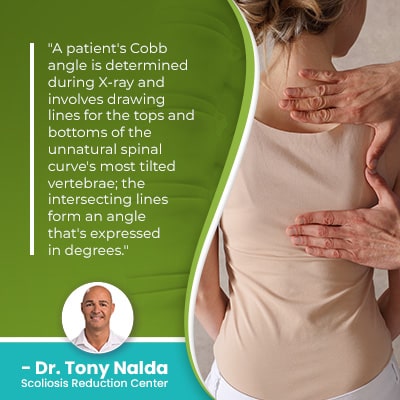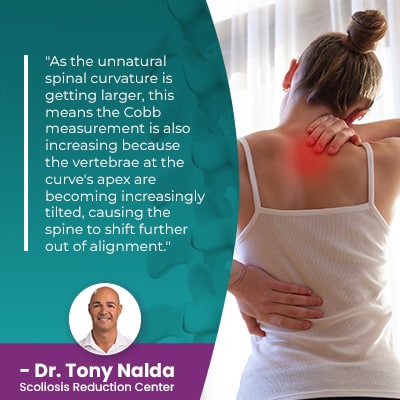Cobb's Angle: How The Cobb Angle Measures Scoliosis

Part of diagnosing and assessing scoliosis involves further classifying conditions based on key patient/condition variables, one of which is condition severity, and this is determined by a patient's Cobb angle measurement. As a progressive condition, it's important to understand that a patient's Cobb angle can change, especially when left untreated.
A patient's Cobb angle is the most widely used measurement in the diagnosis and assessment of scoliosis. It's taken during x ray and tells me how far out of alignment a scoliotic spine is, while also classifying conditions based on severity. The higher a patient's Cobb angle, the more severe the condition.
Along with a certain Cobb angle measurement, there are specific condition characteristics that have to be present to be officially diagnosed as scoliosis, so let's define scoliosis and the parameters that have to be met to reach a diagnosis.
Table of Contents
How is Scoliosis Diagnosed?
The spine's natural and healthy curves make it stronger, more flexible, and better able to handle mechanical stress incurred during activity.
There are a number of spinal conditions that involve a loss of its healthy curves, but scoliosis has some characteristics that set it apart from the rest.
Scoliosis involves the development of an unnatural sideways spinal curve, and a scoliotic spine doesn't just bend unnaturally to the side, but also twists, and it's the rotational component that makes scoliosis a complex 3-dimensional condition.
In addition, the scoliotic curve has to be of a minimum size to be diagnosed as scoliosis: Cobb angle measurement of at least 10 degrees.
Considering that the Scoliosis Research Society has current estimates at close to seven million people currently living with scoliosis in the United States alone, this is a highly-prevalent spinal condition that people need to be aware of; in addition, scoliosis is the leading spinal condition amongst school-aged children.
So if the aforementioned guidelines have been met, a diagnosis of scoliosis is given, so let's talk more about Cobb angle: how it's measured and what it means.
Having a Cobb Angle Measured
 A patient's Cobb angle is determined during X-ray and involves drawing lines for the tops and bottoms of the unnatural spinal curve's most tilted vertebrae; the intersecting lines form an angle that's expressed in degrees.
A patient's Cobb angle is determined during X-ray and involves drawing lines for the tops and bottoms of the unnatural spinal curve's most tilted vertebrae; the intersecting lines form an angle that's expressed in degrees.
When the spine's natural curves are in place, the vertebrae (bones of the spine) are aligned and stacked on top of one another in a straight and neutral position, but if one or more become unnaturally tilted, this shifts the spine out of alignment, and can cause a number of issues.
So a Cobb angle measurement of at least 10 degrees is needed to be considered a true scoliosis, and 10 degrees was decided, somewhat arbitrarily, as the diagnostic cutting-off point in an effort to establish a consistent diagnostic process.
Not only does a patient's Cobb angle measurement tell me how far out of alignment a scoliotic spine is, it's also a measurement that classifies conditions in terms of severity:
- Mild scoliosis: Cobb angle measurement of between 10 and 25 degrees
- Moderate scoliosis: Cobb angle measurement of between 25 and 40 degrees
- Severe scoliosis: Cobb angle measurement of 40+ degrees
- Very-severe scoliosis: Cobb angle measurement of 80+ degrees
So as you can, there is a wide range of Cobb angles and a wide range of severity levels, and remember, as a progressive condition, where a scoliosis is at the time of diagnosis is not indicative of where it will stay; progression can significantly change measurements.
Scoliosis is Progressive
As a progressive condition, scoliosis has it in its very nature to get worse over time, and this means that the size of the unnatural spinal curve is increasing, the condition's uneven forces being exposed to the body are also increasing, as are their effects.
 As the unnatural spinal curvature is getting larger, this means the Cobb measurement is also increasing because the vertebrae at the curve's apex are becoming increasingly tilted, causing the spine to shift further out of alignment.
As the unnatural spinal curvature is getting larger, this means the Cobb measurement is also increasing because the vertebrae at the curve's apex are becoming increasingly tilted, causing the spine to shift further out of alignment.
So let's take a moment to talk about how the condition affects the body, and again, the higher a patient's Cobb angle, the more severe the condition, and the more noticeable its effects are likely to be.
Scoliosis can affect all ages, but it is most commonly diagnosed in adolescents between the ages of 10 and 18 as adolescent idiopathic scoliosis.
The idiopathic classification means not clearly associated with a single-known cause; in other words, we don't fully understand what triggers its initial onset, and idiopathic scoliosis is the most common type to affect both children and adults.
We do, however, know what triggers scoliosis to progress: growth and development.
So we know that in patients who have not yet reached skeletal maturity, they are at risk for rapid-phase progression, particularly in adolescent idiopathic scoliosis patients as they are in, or are entering into, the stage of puberty characterized by rapid and unpredictable growth spurts.
As scoliosis is progressing, the curve's most tilted vertebra is going to become more tilted, and the best remedy for this is proactive treatment that works towards a curvature reduction, meaning the patient's Cobb angle measurement decreases as the condition is impacted on a structural level.
Scoliosis Treatment Options
As mentioned, as a progressive condition, a patient is unlikely to have the same Cobb angle throughout their scoliosis journey because scoliosis is not a static condition.
There are two main scoliosis treatment approaches: traditional and conservative.
Traditional scoliosis treatment involves an orthopaedic doctor and tends to funnel patients towards invasive spinal fusion surgery; spinal fusion is a costly and risky procedure that involves fusing the curve's most tilted vertebrae into one solid bone, and this is done to eliminate movement (progression) in the area.
Rods are also attached to the spine to hold it in place, and hardware used is permanent, so the whole spine is affected, and a fused spine is fused for life.
What many patients find post-surgery is that the fused section of the spine is excessively rigid, making it less flexible and causing a reduced range motion that can impact a patient's lifestyle and overall quality of life.
For patients on the path of traditional scoliosis treatment, little is done to prevent progression, but once a patient progresses into the severe classification at a Cobb angle measurement of 40+ degrees, with signs of continued progression, they become a surgical candidate.
Conservative Scoliosis Treatment
Fortunately, for those who choose to forgo a surgical recommendation, or who simply want to try a less-invasive and more natural form of treatment first, conservative treatment offers a proactive non-surgical treatment alternative, and the reality is that many cases of scoliosis don't require surgery.
Here at the Scoliosis Reduction Center, I treat my scoliosis patients with a conservative chiropractic-centered treatment approach that integrates multiple condition-specific treatment disciplines for the best potential results.
I want to work towards preventing curvature increases by being proactive, and this means starting treatment as close to the time of diagnosis as possible, when the condition is going to be at its mildest, before significant progression has occurred, making the spine more rigid and less responsive to treatment.
I combine chiropractic care, physical therapy, corrective bracing, and rehabilitation so conditions can be impacted on every level.
As an unnatural structural curve, scoliosis has to be impacted, first and foremost, on a structural level, which I work towards through a series of chiropractic adjustments that can achieve consistent positioning of the most tilted vertebrae back into alignment with the rest of the spine.
Physical therapy is used to increase core strength so the spine is optimally supported by its surrounding muscles, improve posture, achieve a more natural body positioning, activate certain areas of the brain for improved brain-body communication, and address any muscle imbalances.
Corrective bracing can be particularly effective on growing spines by pushing the spine into a corrective position.
Rehabilitation involves a series of custom-prescribed exercises that patients can perform easily from home; this helps them establish a home-rehabilitation program to further stabilize and heal the spine.
Conclusion
So a Cobb angle measures scoliosis via radiographic evaluation and involves drawing lines from the tops and bottoms of the scoliotic curve's most tilted vertebrae, and the resulting angle is expressed in degrees, and the higher the degree, the further out of alignment the scoliotic spine is.
When a spine is misaligned, a lot of uneven forces are being introduced to the spine, its surrounding muscles, nerves, and the rest of the body.
The main scoliosis symptom in children is postural deviation, and in adults, it's pain; the more severe a condition, the more likely it is to be painful, and rotation also factors in; a minor rotation is still problematic, but won't be as painful or problematic as a large angle of trunk rotation (ATR).
As scoliosis doesn't become a compressive condition until skeletal maturity has been reached, this is when the spine and its surroundings becomes vulnerable to the unnatural curve's compressive force, and this is why scoliosis isn't commonly described as painful for children.
So as scoliosis is corrected, this means the size of the unnatural curvature of the spine is reduced, which means Cobb angle measurements also decrease as the affected vertebrae become less tilted.
A patient's Cobb angle is a precise measurement that helps shape the design of effective treatment plans, and the more we know about a patient's condition, the better.
Regardless of a patient's Cobb angle measurement at the time of diagnosis, treatment is needed to work towards counteracting the condition's progressive nature, and to avoid measuring error, a scoliosis specialist should be performing the x ray; it takes a lot of training and experience to comprehensively interpret the results of a scoliosis x ray.
Regardless of a patient's Cobb angle measurement, as a progressive condition, the best time to start treatment is always now.
Dr. Tony Nalda
DOCTOR OF CHIROPRACTIC
After receiving an undergraduate degree in psychology and his Doctorate of Chiropractic from Life University, Dr. Nalda settled in Celebration, Florida and proceeded to build one of Central Florida’s most successful chiropractic clinics.
His experience with patients suffering from scoliosis, and the confusion and frustration they faced, led him to seek a specialty in scoliosis care. In 2006 he completed his Intensive Care Certification from CLEAR Institute, a leading scoliosis educational and certification center.
About Dr. Tony Nalda
 Ready to explore scoliosis treatment? Contact Us Now
Ready to explore scoliosis treatment? Contact Us Now





